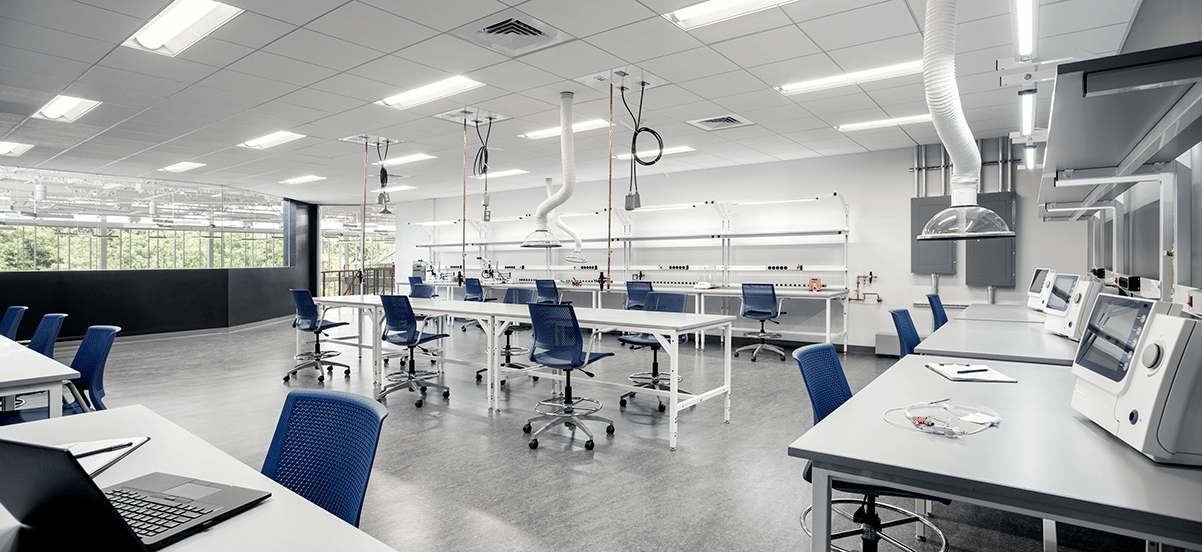Upgrading or increasing the capacity of school laboratories and makerspace is a question on the minds of leadership teams at private religious schools these days. How so?
The pandemic plays a part in this, both directly and indirectly. Let’s start with the direct part.
Many students are in need of significant catchup, particularly in STEM subjects, as a direct result of the pandemic. In particular, students who received a significant portion of their education via remote instruction during the pandemic have fallen behind in acquiring skills in lab science and practical engineering technology that they would normally acquire through hands-on, project-based learning in the school lab or a makerspace.
Even if your own school maintained in-person teaching throughout the pandemic, your student population might be affected over time, as new students needing “catch up” transfer to your school from other institutions.
Either way, the result is a greater need for increased capacity in school laboratories and makerspaces.
What about the indirect causes and effects of the pandemic? How is this affecting demand for school laboratories and makerspaces?
Here, we can point to the growing demand for STEM-based career skills. During the pandemic, investment has surged into the biotech, healthcare, and related fields, making these among the fastest growing sectors for professional career paths.
This means that graduating students who can demonstrate mastery of STEM skills will enjoy a significant advantage applying to higher education programs or when seeking a coveted position in today’s high-demand careers.
Either scenario is welcome news for your school – either by enhancing your reputation as a launching pad for students successfully applying to prestigious colleges and universities or by helping your graduates jump-start their professional careers.
Can you create a productive laboratory or makerspace from empty space in just a matter of months – without building new walls?
The leadership at many private Christian schools faces the age-old challenge of how to strive for excellence while adhering to a limited budget. While the Biden administration has promised more investment, particularly in high schools, it’s unclear if and when that would reach Christian educational institutions.
For many of us, capital budgets are particularly tight right now, especially after implementing so many expensive emergency measures due to the pandemic.
Fortunately, there are some new approaches to building laboratories and makerspaces that can dramatically cut the cost and the time needed to get up and running – even allowing you to convert empty space into a productive lab or makerspace in a just a matter of months without embarking on extensive construction projects.
What’s the secret?
The answer lies in a new approach to facility construction that allows any room to be converted into a lab or makerspace – by installing next-generation, free-standing workbench modules.
Unlike traditional lab construction projects, which can take months to build, these new high-tech lab and makerspace designs are custom built-to-order at the factory, then shipped in flat packs directly to your location for onsite assembly. This approach reduces shipping costs significantly while cutting down on overall construction labor and material waste. It also helps future-proof your investment, as the lab benches can be disassembled and moved to new locations if your needs change over time.
Customizing the order at the factory offers other significant advantages.
We’ve already mentioned that these free-standing benches don’t rely on walls for support, but they have other tricks up their sleeve, as well. For example, overhead utility hookups are built-in at the factory, including all the necessary electric power supplies and outlets, up to four different gas type hookups (for laboratory use), as well as water for wet sink modules.
This dramatically simplifies installation. You only need to drop utilities down from the ceiling, not build them out from the walls, saving significant time on labor and money on materials.
These modern modular, free-standing labs benches are also built to last, made of high-strength steel with a durable powder-coated finish, with a variety of long-lasting work surface materials, from durable hardwood maple to the traditional laboratory look of black phenolic resin. Or, you may want to specify other durable, chemical-resistant materials, such as stainless steel or epoxy resin, depending on your needs.
Finally, flexibility is another key feature. For example, you can segregate different classes or age groups to use one side of the lab or the other as needed.
And, the work surfaces can be adjusted vertically to accommodate different-aged students who either want to work in a seated position or while standing up – allowing one installation to fit sizes ranging from the little ones who need low mounted desks all the way up to your basketball players who prefer to stand while performing science experiments.
This article is courtesy of Formaspace, a leading manufacturer of all American-made laboratory and makerspace furniture systems for college, university, and K-12 school systems, www.formaspace.com.










